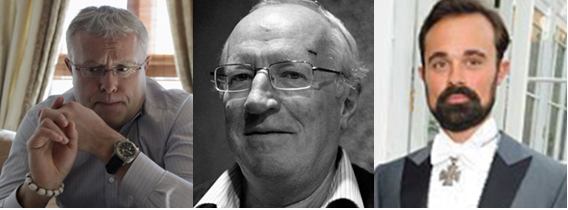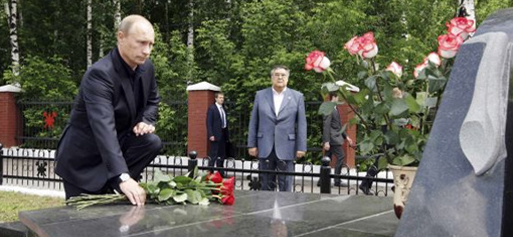FATHER CHRISTMAS MAKES A PROMISE TO DELIVER THE TRUTH, BUT FIRST TO TIE UP THE LIARS
by John Helmer - Dances with Bears
@bears_with“From now onwards you tell the truth, and that’s it”, Robert Fisk, one of the few British journalists who do, explained recently for a television documentary that this was the credo he learned from his job.
Still, it’s the time of the year when you and I wish each other the hope that the future will turn out better than it’s proved to be recently; and when we take time for reflection on the likelihood of this; also the time to gather the energy to cope with the greater unlikelihood.
The truth-telling conviction came to Fisk, he says, after the massacre of Palestinians at the Sabra and Chatila refugee camps in Beirut, in September 1982 – the systematic killing of thousands by Lebanese gunmen connived at and protected by the Israel Defence Forces.
Fisk’s credo, he also explains, is that seeing is believing: that after the massacre,
“...from then onwards I felt that nothing would stop me going into look at these things, see them, that there was something different from just journalism because these were the people who suffer, and they’re the people whom we should be writing about. These people would want me to be here. Their corpses would want me to tell their story. After this I had a self-confidence in writing about brutality and war crimes that I never would have had before. That’s the end of allowing fear to make the decisions for you. That’s the end of being frightened of gunmen and editors, and being accused of being anti-Semitic.”
MAP OF RUSSIA AND LEBANON; THE ISRAELI INVASION OF LEBANON TO THE BEIRUT LINE, JUNE 1982; SABRA AND CHATILA CAMPS, SEPTEMBER 1982
CLICK ON IMAGES TO ENLARGE
Sabra and Chatila camps were located just west of the Muslim-Christian dividing line in Beirut (dotted line on the third map), lying west of the Israeli military encirclement (green line). For map details
For the projection of live emotions on to inanimate things, and back again, corpses aren’t different from lonely clouds in the sky, gleeful waves, or dancing daffodils. When writers do it, the projection is called the pathetic fallacy. It’s an easy fallacy to fall for. With it, writers have been padding out their egos and pockets for as long as there have been paying readers: whether it’s been Mother Nature or the Grim Reaper doesn’t change the fallacy that it is.
Seeing isn’t believing – it’s the other way round. A policeman I know used to say — on the whole people don’t see what they don’t believe they can see. Reporters aren’t different from policemen, though for reporters the scope for honest employment is much less, especially these days. It’s the money which counts – corpses are better paying in the media than fields of daffodils.
Left to right: Alexander Lebedev; Robert Fisk; Yevgeny Lebedev.
In his magnum opus on the Middle East, “The Great War for Civilization”, Fisk has nothing but unresearched clichés to report on Soviet or Russian policy-making; no sources; no sympathy. Vladimir Putin, Fisk dismissed in a phrase, “the killer of Grozny”. The most expert of Russians on the Middle East Fisk disposed of at Hafez al-Assad’s funeral in Damascus in June 2000 by his last name, Primakov; Fisk didn’t bother to look up his first name Yevgeny.
Soviet forces were invaders in Afghanistan, he reported. “There were rather a lot of Muslims in the Soviet Union. And that, surely, was partly what this whole invasion was about.” A reporter who believes “surely” but sees “partly” admits he doesn’t know what he’s doing. Instead, he saves himself with a corpse.
“There was little evidence of the ambushed convoy in front”, Fisk reported from a patrol, “save for the feet of a dead man being hurriedly pushed into a Soviet army van near Charikar [Afghanistan] and a great swath of crimson and pink slush…down one side of the road.”
Three corpses who might want me to tell their story are as close to me as it’s possible to be. My aunt and my grandmother were murdered in 1939; my sister was murdered in 1988. I am not sure I’ve enough evidence to name those who did the actual killing; I know who was responsible, and to those of them still alive I send reminders from time to time that I will go on telling the truth about them.
But what of the millions of Russians who have died since I became a foreign correspondent in Moscow in February 1989. By my count, at least 3 million, probably double that number of Russians died in the decade that followed who would have lived if not for Boris Yeltin, Yegor Gaidar and Anatoly Chubais seizing state power and then, under US prompting and protection, implementing policies to destroy Russian livelihoods and lives. Another 25 million farm animals were also killed; more of them by far than Stalin and Hitler, combined, caused to be destroyed between 1930 and 1945.
Seeing this can’t be believing because the Anglo-American press corps believed something else was happening; reform they called it. No one reported seeing the three million die at the time; also because the slaughter of livestock doesn’t qualify as a holocaust, a genocide, or even a holodomor. The controversies over the meaning of that last Ukrainian word, and also of the calculation of “excess mortality” during Stalin’s collectivization campaign for which the word has been coined, don’t usually extend to the “excess mortality” of Russians.
Ukrainian or North American calculations are too committed to Russia-hating to count “excess mortality” among Russians; the more of that the better, they think and even publish. This essay by John-Paul Himka explains how many fallacies run under the holodomor term, and what truth can be found.
“Journalists,” Fisk recommends, “must also be historians”. Himka explains why, in Ukrainian history and politics, they turn out to be at much the same distance from both the seeing and the believing, and thus from the truth.
Excess mortality is a concept. It’s invisible — it doesn’t attract flies or stain snow and sand. But it’s an efficient killer of very large numbers. To have a chance of seeing it, you have to suspect it first, know what to look for, then try to find the traces (or their absence). It’s like methane and canaries in Russian coal-mines privatized into the hands of individuals like Roman Abramovich and Alexander Abramov, and kept there by men like the long-serving Kemerovo governor Aman Tuleyev. For how methane kills, and why, read the backfile. Not a word of this was published in the international mainstream media nor in the specialized steel
and coal media.
Prime Minister Putin and Kemerovo Governor Tuleyev at the Novokuznetsk cemetery, following the second worst coal-mine explosion of methane in modern Russian history in May 2010; 91 were killed. The worst occurred in March 2007, also in Kemerovo region; 108 were killed.
In Russia, foreign journalists have been canaries of a very different feather. They don’t sing; they squeal. For celebration of the holidays and the year ahead, I wish you the acuity to see the difference; and for myself the continuing belief there is one. Remember me — Dido sings in the famous lament to the women of her court after Aeneas leaves her, in Henry Purcell’s opera of 1689. It’s the loss of hope Purcell’s aria will memorialize always. “Remember me, remember me, but ahhhhh, forget my fate.”
There’s that, too — though if Purcell had not made such a beautiful song of the words, I would not be so sure.




No comments:
Post a Comment